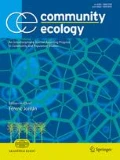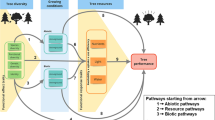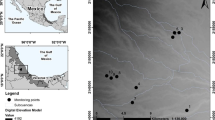Abstract
Shrubs in pastures are expected to adversely affect plant species diversity and community composition at various spatial scales. We recorded vegetation composition as well as light conditions and other environmental variables in 105 1 m2 plots nested in 35 sampling sites in shrubby pastures in Romanian Banat. We used generalized linear models, generalized linear mixed-effects models, and linear regression to find determinants of species turnover and richness at patch and community level. We expected shrubs to negatively influence species richness on the patch level but to introduce spatial heterogeneity to the light availability resulting in a unimodal relationship of light availability with species richness on the community level. Species turnover was significantly influenced by light conditions, grazing variability, and distance between the plots. We found a unimodal relationship between light availability and species richness consistently across the two spatial scales in grazed sites. However, the same relationship changed its shape from linear to unimodal in non-grazed sites. Shrubs in pastures may not be considered as a threat to plant species diversity. Instead, they contribute significantly to plant species diversity and vegetation heterogeneity.





Similar content being viewed by others
Abbreviations
- αc :
-
Community-level species richness
- αp :
-
Patch-level species richness
- DIF:
-
The percentage of diffuse solar radiation reaching the undergrowth
- DIR:
-
The percentage of direct solar radiation reaching the undergrowth
- GLM:
-
Generalized linear models
- GLMM:
-
Generalized linear mixed-effects models
- IDH:
-
Intermediate disturbance hypothesis
- PDSI:
-
Potential direct solar radiation
- SIM:
-
Multiple-site dissimilarity measure based on the Simpson dissimilarity index (species turnover
References
Adler, P. B., Raff, D. A., & Lauenroth, W. K. (2001). The effect of grazing on the spatial heterogeneity of vegetation. Oecologia,128(4), 465–479.
Angileri, V., Loudjani, P., & Serafini, F. (2011). GAEC implementation in the EU: Situation and perspectives. Italian Journal of Agronomy,6(1s), 2.
Bagaria, G., Helm, A., Rodà, F., & Pino, J. (2015). Assessing coexisting plant extinction debt and colonization credit in a grassland–forest change gradient. Oecologia,179(3), 823–834.
Bakker, E. S., Olff, H., Vandenberghe, C., De Maeyer, K., Smit, R., Gleichman, J. M., et al. (2004). Ecological anachronisms in the recruitment of temperate light-demanding tree species in wooded pastures. Journal of Applied Ecology,41(3), 571–582.
Baselga, A. (2010). Partitioning the turnover and nestedness components of beta diversity. Global Ecology and Biogeography,19, 134–143.
Baselga, A., Jiménez-Valverde, A., & Niccolini, G. (2007). A multiple-site similarity measure independent of richness. Biology Letters,3(6), 642–645.
Baselga, A., & Orme, C. D. L. (2012). betapart: An R package for the study of beta diversity. Methods in Ecology and Evolution,3(5), 808–812.
Bates, D., Mächler, M., Bolker, B., & Walker, S. (2015). Fitting linear mixed-effects models using lme4. Journal of Statistical Software,67(1), 1–48.
Bergmeier, E., Petermann, J., & Schröder, E. (2010). Geobotanical survey of wood-pasture habitats in Europe: Diversity, threats and conservation. Biodiversity and Conservation,19(11), 2995–3014.
Bertness, M. D., & Callaway, R. (1994). Positive interactions in communities. Trends in Ecology & Evolution,9(5), 191–193.
Beyer, H.L. (2009). Geospatial modelling environment. Version 0.5.3.0. https://www.spatialecology.com/gme. Accessed 14 July 2011.
Bowers, M. A. (1993). Influence of herbivorous mammals on an old-field plant community: Years 1–4 after disturbance. Oikos,67(1), 129–141.
Breshears, D. D., Nyhan, J. W., Heil, C. E., & Wilcox, B. P. (1998). Effects of woody plants on microclimate in a semiarid woodland: Soil temperature and evaporation in canopy and intercanopy patches. International Journal of Plant Sciences,159(6), 1010–1017.
Cavieres, L. A., & Badano, E. I. (2009). Do facilitative interactions increase species richness at the entire community level? Journal of Ecology,97(6), 1181–1191.
Connell, J. H. (1978). Diversity in tropical rain forests and coral reefs. Science,199(4335), 1302–1310.
Crawley, M. J. (2007). The R book. Hoboken, NJ: Wiley.
Cribari-Neto, F., & Zeileis, A. (2010). Beta regression in R. Journal of Statistical Software,34(2), 1–24.
Dostálek, J., & Frantík, T. (2008). Dry grassland plant diversity conservation using low-intensity sheep and goat grazing management: Case study in Prague (Czech Republic). Biodiversity and Conservation,17(6), 1439–1454.
Dzwonko, Z., & Loster, S. (2007). A functional analysis of vegetation dynamics in abandoned and restored limestone grasslands. Journal of Vegetation Science,18(2), 203–212.
Elias, D., & Tischew, S. (2016). Goat pasturing—A biological solution to counteract shrub encroachment on abandoned dry grasslands in Central Europe? Agriculture, Ecosystems & Environment,234(Supplement C), 98–106.
Forejt, M., Skalos, J., Pereponova, A., Plieninger, T., Vojta, J., & Šantrůčková, M. (2017). Changes and continuity of wood-pastures in the lowland landscape in Czechia. Applied Geography,79, 235–244.
Fox, J. W. (2013). The intermediate disturbance hypothesis should be abandoned. Trends in Ecology & Evolution,28(2), 86–92.
Frazer, G. W., Canham, C. D., & Lertzman, K. P. (1999). Gap light analyzer (GLA): Imaging software to extract canopy structure and gap light transmission indices from true-colour fisheye photographs. Burnaby, BC: Simon Fraser University.
Jakobsson, S., & Lindborg, R. (2015). Governing nature by numbers—EU subsidy regulations do not capture the unique values of woody pastures. Biological Conservation,191, 1–9.
John, R., Dalling, J. W., Harms, K. E., Yavitt, J. B., Stallard, R. F., Mirabello, M., et al. (2007). Soil nutrients influence spatial distributions of tropical tree species. Proceedings of the National academy of Sciences of the United States of America,104(3), 864–869.
Kelemen, A., Tolgyesi, C., Kun, R., Molnar, Z., Vadasz, C., & Toth, K. (2017). Positive small-scale effects of shrubs on diversity and flowering in pastures. Tuexenia,37, 399–413.
Kelemen, A., Tölgyesi, C., Valkó, O., Deák, B., Miglécz, T., Fekete, R., et al. (2019). Density-dependent plant–plant interactions triggered by grazing. Frontiers in Plant Science,10, 1–6.
Kesting, S., Petersen, U., & Isselstein, J. (2015). Humped-back shaped response of plant species richness to increasing shrub encroachment in calcareous grasslands. Community Ecology,16(2), 189–195.
Kidron, G. J., & Gutschick, V. P. (2013). Soil moisture correlates with shrub–grass association in the Chihuahuan Desert. Catena,107, 71–79.
Lavorel, S. (1994). Predicting richness of native, rare, and exotic plants in response to habitat and disturbance variables across a variegated landscape. Conservation Biology,8(2), 521–531.
Maděra, P., Kovář, P., Romportl, D., Buček, A., et al. (2014). Czech villages in Romanian Banat: Landscape, nature and culture. Brno, CZ: Mendel University in Brno.
McCune, B., & Keon, D. (2002). Equations for potential annual direct incident radiation and heat load. Journal of Vegetation Science,13(4), 603–606.
Michielsen, M., Szemák, L., Fenesi, A., Nijs, I., & Ruprecht, E. (2017). Resprouting of woody species encroaching temperate European grasslands after cutting and burning. Applied Vegetation Science,20(3), 388–396.
Milchunas, D. G., Sala, O. E., & Lauenroth, W. K. (1988). A generalized model of the effects of grazing by large herbivores on grassland community structure. American Naturalist,132(1), 87–106.
Oldén, A., & Halme, P. (2016). Grazers increase β-diversity of vascular plants and bryophytes in wood-pastures. Journal of Vegetation Science,27(6), 1084–1093.
Olff, H., & Ritchie, M. E. (1998). Effects of herbivores on grassland plant diversity. Trends in Ecology & Evolution,13(7), 261–265.
Oom, S. P., Sibbald, A. M., Hester, A. J., Miller, D. R., & Legg, C. J. (2008). Impacts of sheep grazing a complex vegetation mosaic: Relating behaviour to vegetation change. Agriculture, Ecosystems & Environment,124(3–4), 219–228.
Pihlgren, A., & Lennartsson, T. (2008). Shrub effects on herbs and grasses in semi-natural grasslands: Positive, negative or neutral relationships? Grass & Forage Science,63(1), 9–21.
Plieninger, T., Hartel, T., Martín-López, B., Beaufoy, G., Bergmeier, E., Kirby, K., et al. (2015). Wood-pastures of Europe: Geographic coverage, social–ecological values, conservation management, and policy implications. Biological Conservation,190, 70–79.
Pornaro, C., Schneider, M. K., & Macolino, S. (2013). Plant species loss due to forest succession in alpine pastures depends on site conditions and observation scale. Biological Conservation,161, 213–222.
Poschlod, P., Karlík, P., Baumann, A., & Wiedmann, B. (2008). The history of dry calcareous grasslands near Kallmünz (Bavaria) reconstructed by the application of palaeoecological, historical and recent-ecological methods. In P. Szabó & R. Hédl (Eds.), Human nature: Studies in historical ecology and environmental history (pp. 130–143). Brno, CZ: Institute of Botany of the Czech Academy of Sciences.
Pugnaire, F. I., Haase, P., & Puigdefábregas, J. (1996). Facilitation between higher plant species in a semiarid environment. Ecology,77(5), 1420–1426.
Pugnaire, F. I., & Luque, M. T. (2001). Changes in plant interactions along a gradient of environmental stress. Oikos,93(1), 42–49.
Pykälä, J., Luoto, M., Heikkinen, R. K., & Kontula, T. (2005). Plant species richness and persistence of rare plants in abandoned semi-natural grasslands in northern Europe. Basic and Applied Ecology,6(1), 25–33.
R Core Team. (2015). R: A language and environment for statistical computing. Vienna: R Foundation for Statistical Computing.
Ratajczak, Z., Nippert, J. B., & Collins, S. L. (2012). Woody encroachment decreases diversity across North American grasslands and savannas. Ecology,93(4), 697–703.
Rejmánek, M., & Rosén, E. (1992). Influence of colonizing shrubs on species-area relationships in alvar plant communities. Journal of Vegetation Science,3(5), 625–630.
Řepka, R., Maděra, P., Hrubý, Z., & Koutecký, T. (2014). Floristic characterisation of biotope types. In P. Maděra, P. Kovář, D. Romportl, & A. Buček (Eds.), Czech villages in Romanian Banat: Landscape, nature and culture (pp. 113–143). Brno, CZ: Mendel University.
Romportl, D., Havlíček, M., Chuman, T., Skokanová, H., & Šantrůčková, M. (2014). The development of land use and landscape structure. In P. Maděra, P. Kovář, D. Romportl, & A. Buček (Eds.), Czech villages in Romanian Banat: Landscape, nature and culture (pp. 277–291). Brno, CZ: Mendel University.
Roxburgh, S. H., Shea, K., & Wilson, J. B. (2004). The intermediate disturbance hypothesis: Patch dynamics and mechanisms of species coexistence. Ecology,85(2), 359–371.
Sakamoto, Y., Ishiguro, M., & Kitagawa, G. (1986). Akaike information criterion statistics in mathematics and its applications. Dordrecht: Springer.
Šantrůčková, M., & Klvač, P. (2014). The history and present of Czech settlements in the Romanian Banat. In P. Maděra, P. Kovář, D. Romportl, & A. Buček (Eds.), Czech villages in Romanian Banat: Landscape, nature and culture (pp. 33–48). Brno, CZ: Mendel University.
Sârbu, I., Ştefan, N., & Oprea, A. (2013). Plante vasculare din România. Determinator ilustrat de teren (Vascular plants of Romania. An illustrated field guide). Bucureşti, RO: Victor B Victor.
Škornik, S., Sajna, N., Kramberger, B., Kaligarič, S., & Kaligarič, M. (2008). Last remnants of riparian wooded meadows along the middle Drava river (Slovenia): Species composition is a response to light conditions and management. Folia Geobotanica,43(4), 431–445.
Soliveres, S., Eldridge, D. J., Maestre, F. T., Bowker, M. A., Tighe, M., & Escudero, A. (2011). Microhabitat amelioration and reduced competition among understorey plants as drivers of facilitation across environmental gradients: Towards a unifying framework. Perspectives in Plant Ecology, Evolution and Systematics,13(4), 247–258.
Soliveres, S., Maestre, F. T., Eldridge, D. J., Delgado-Baquerizo, M., Quero, J. L., Bowker, M. A., et al. (2014). Plant diversity and ecosystem multifunctionality peak at intermediate levels of woody cover in global drylands. Global Ecology and Biogeography,23(12), 1408–1416.
Soliveres, S., Maestre, F. T., Ulrich, W., Manning, P., Boch, S., Bowker, M. A., et al. (2015). Intransitive competition is widespread in plant communities and maintains their species richness. Ecology Letters,18(8), 790–798.
Stoate, C., Báldi, A., Beja, P., Boatman, N. D., Herzon, I., van Doorn, A., et al. (2009). Ecological impacts of early 21st century agricultural change in Europe—A review. Journal of Environmental Management,91(1), 22–46.
Tálamo, A., Barchuk, A., Cardozo, S., Trucco, C., Marás, G., & Trigo, C. (2015). Direct versus indirect facilitation (herbivore mediated) among woody plants in a semiarid Chaco forest: A spatial association approach. Austral Ecology,40, 573–580.
Varga, A., Molnár, Zs., Biró, M., Demeter, L., Gellény, K., Miókovics, E., et al. (2016). Changing year-round habitat use of extensively grazing cattle, sheep and pigs in East-Central Europe between 1940 and 2014: Consequences for conservation and policy. Agriculture, Ecosystems & Environment,234(Supplement C), 142–153.
Vojta, J., Kovář, P., & Volařík, D. (2014). Patterns of grazing and plant species diversity in the pasturelands. In P. Maděra, P. Kovář, D. Romportl, & A. Buček (Eds.), Czech villages in Romanian Banat: Landscape, nature and culture (pp. 153–163). Brno, CZ: Mendel University.
Vujnovic, K., Wein, R. W., & Dale, M. R. T. (2002). Predicting plant species diversity in response to disturbance magnitude in grassland remnants of central Alberta. Canadian Journal of Botany,80(5), 504–511.
Weiner, J. (1990). Asymmetric competition in plant populations. Trends in Ecology & Evolution,5, 360–364.
Wilson, J. B. (1994). The ‘Intermediate disturbance hypothesis’ of species coexistence is based on patch dynamics. New Zealand Journal of Ecology,18(2), 176–181.
Acknowledgements
We thank Lucie Kačmarová, Magdalena Klárová, Marie Smyčková, Adam Veselý, and Pavel Wiesner for their help with fieldwork. We thank three anonymous reviewers and editor Ladislav Mucina for their useful comments on the manuscript. The work was supported by the Operational Programme Education for Competitiveness “Creation and development of a multidisciplinary team on the platform of landscape ecology” (CZ.1.07/2.3.00/20.0004) with the contribution of EU resources and resources from the state budget of the Czech Republic.
Author information
Authors and Affiliations
Corresponding author
Additional information
Nomenclature: Sârbu et al. (2013).
Electronic supplementary material
Below is the link to the electronic supplementary material.
Rights and permissions
About this article
Cite this article
Vojta, J., Volařík, D. & Kovář, P. Interaction between light availability and grazing enhances species richness and turnover of vascular plants in shrubby pastures in Romania. COMMUNITY ECOLOGY 21, 67–77 (2020). https://doi.org/10.1007/s42974-020-00007-6
Received:
Accepted:
Published:
Issue Date:
DOI: https://doi.org/10.1007/s42974-020-00007-6




